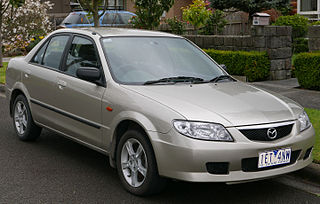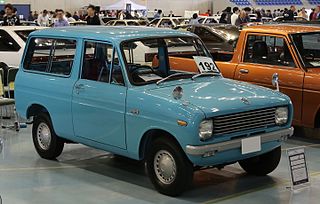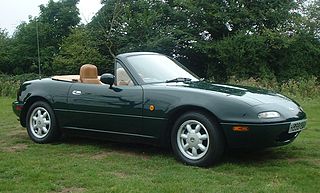
Mazda Motor Corporation, also known as simply Mazda, is a Japanese multinational automotive manufacturer headquartered in Fuchū, Hiroshima, Japan. The company was founded on January 30, 1920, as Toyo Cork Kogyo Co., Ltd., a cork-making factory, by Jujiro Matsuda. It changed its name to Toyo Kogyo Co., Ltd. in 1927 and started producing vehicles in 1931. The name Mazda was derived from Ahura Mazda, the god of harmony, intelligence and wisdom in Zoroastrianism, as well as from the surname of the founder. Mazda is one of the largest automakers in Japan and the world. In 2015, it produced 1.5 million vehicles for global sales, of which nearly one million were made in Japan and the rest in various other countries. It ranked as the 15th-largest automaker by production volume globally in 2015. Mazda is known for its innovative technologies, such as the Wankel engine, the SkyActiv platform, and the Kodo Design language. It also has a long history of motorsport involvement, winning the 24 Hours of Le Mans in 1991 with the rotary-powered Mazda 787B. Mazda has several alliances and partnerships with other automakers, such as Toyota, Nissan, Isuzu, Suzuki and Ford.

The Mazda MX-5 is a lightweight two-passenger sports car manufactured and marketed by Mazda with a front mid-engine, rear-wheel-drive layout. The convertible is marketed as the Mazda Roadster or Eunos Roadster in Japan, and as the Mazda Miata in the United States, and formerly in Canada, where it is now marketed as the MX-5 but is still commonly referred to as Miata.

The Mazda RX-8 is a sports car manufactured by Japanese automobile manufacturer Mazda between 2002 and 2012. It was first shown in 2001 at the North American International Auto Show. It is the direct successor to the RX-7. Like its predecessors in the RX range, it is powered by a rotary Wankel engine. The RX-8 was available for the 2003 model year in most parts of the world.

The Mazda MX-3 is a four-seat, front wheel drive coupé manufactured and marketed by Mazda, introduced at the Geneva Auto Show in March 1991 and marketed for model years 1992–1998.

Mazdaspeed was Mazda's in-house performance division. The company was a grassroots racing team in Japan. Owned by Mazda Motor Corporation, they built production model vehicles, became involved in motorsports development, and offered performance parts and accessories. Mazda has phased out Mazdaspeed branding and has not offered a Mazdaspeed trim since the 2013 Mazdaspeed3.

The Mazda Carol is a kei car manufactured by Mazda from 1962 until 1970. The Carol name was revived again with Mazda's 1989 re-entry into the kei car class with the Autozam brand. Since 1989, the Carol has been a rebadged model manufactured by Suzuki for Mazda, based on the Japanese Suzuki Alto. The first two generations of the modern era Carols received unique bodywork, but since late 1998 the nameplate has been strictly a badging exercise.

The Mazda MX-6 is a front-engine, front-wheel-drive coupé manufactured and marketed by Mazda from 1987 to 1997 across two generations.

The Mazda Familia, also marketed prominently as the Mazda 323, Mazda Protegé and Mazda Allegro, is a small family car that was manufactured by Mazda between 1963 and 2003. The Familia line was replaced by the Mazda3/Axela for 2004.

The Mazda Porter and Porter Cab are a series of small kei trucks that were produced from 1961 to 1989 by Mazda, mainly for sale in the domestic Japanese market. Export versions of the Porter were labelled E360. The Porter was replaced by the Autozam Scrum, a rebadged Suzuki Carry.
The Mazda B-series engine - not to be confused with the Mazda B-Series truck - is a small-sized, iron-block, inline four-cylinder with belt-driven SOHC and DOHC valvetrain ranging in displacement from 1.1 to 1.8 litres. It was used from front-wheel drive economy applications to the turbocharged full-time 4WD 323 GTX and rear-wheel drive Miata as well as numerous other models. The Mazda B-series is a "non-interference" design, meaning that breakage of its timing belt does not result in damage to valves or pistons, because the opening of the valves, the depth of the combustion chamber and the shaping of the piston crown allow sufficient clearance for the open valves in any possible piston position.

Autozam was a brand of Japanese automaker Mazda, specializing in small cars and Kei cars, many of which were rebadged Suzuki models. Autozam also briefly acted as importer of Lancia vehicles to Japan.

The Mazda6 is a mid-size sedan produced by Mazda since 2002, replacing the long-produced Capella/626.

The Suzuki Cappuccino is a sports car produced by the Japanese company Suzuki from 1991 to 1998. It is a two-seater roadster with a detachable hardtop that is designed to meet Japanese kei car regulations.

The Honda Beat is a kei car produced by the Japanese company Honda from May 1991 until February 1996. It is a two-seater roadster with a rear mid-engine, rear-wheel-drive layout. The last car to be approved by Soichiro Honda before he died in 1991, in total around 33,600 were made, with roughly two-thirds of these built in the first year of production. The design of the car originated from Pininfarina, who then sold the design plan to Honda. The Beat was one of many cars designed to take advantage of Japan's tax-efficient kei car class.

The Suzuki Wagon R is a kei car manufactured and marketed by Suzuki since 1993. The R in the name stands for Revolution and Relaxation. The Wagon R uses a "tall wagon" configuration to maximize cabin space within kei car dimensional restrictions. The Wagon R is also sold by Mazda as the AZ-Wagon from 1994 to 2012 and as the Flair from 2012.

The Suzuki Carry is a kei truck produced by the Japanese automaker Suzuki. The microvan version was originally called the Carry van until 1982 when the passenger van versions were renamed as the Suzuki Every. In Japan, the Carry and Every are kei cars but the Suzuki Every Plus, the bigger version of Every, had a longer bonnet for safety purposes and a larger 1.3-liter 86-hp (63 kW) four-cylinder engine. They have been sold under myriad different names in several countries, including those with Chevrolet and Ford badges.

The Mazda MX-5 (NA) is the first generation of the Mazda MX-5 manufactured from 1989 to 1997. Inspired by the post-war era British sports cars, the MX-5 rejuvenated interest in roadsters after the demise of cars such as the MG B and Triumph Spitfire. Since its debut, the MX-5 has won numerous automotive awards and has become the world's best selling sports car.

The Suzuki F engine is a series of inline three- and four-cylinder internal combustion petrol engines manufactured by Suzuki Motor Corporation and also licensed by many manufacturers for their automobiles. This engine was Suzuki's first four-stroke car engine when it first appeared in 1977.





















